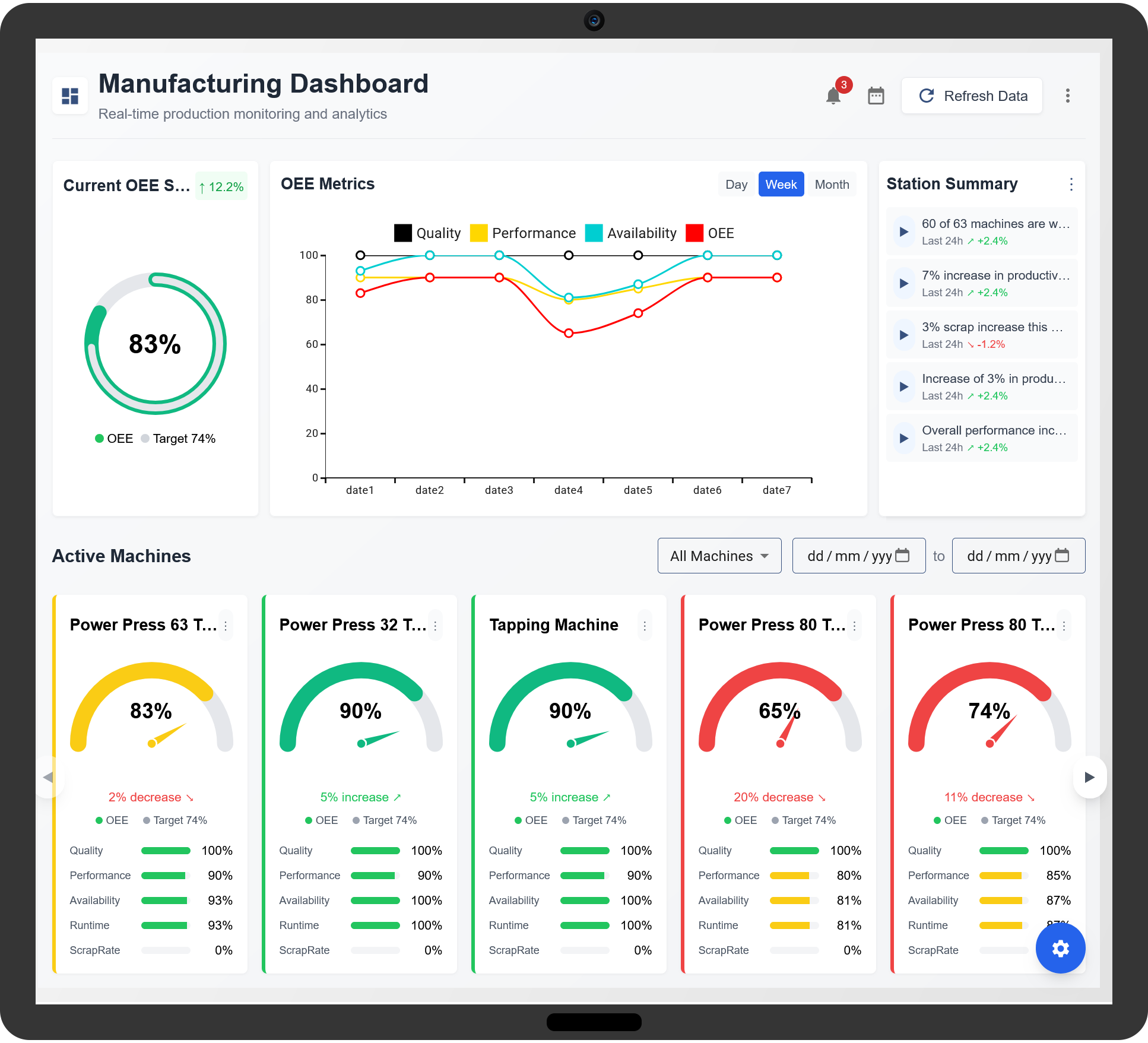Overall Equipment Effectiveness (OEE) software plays a critical role in manufacturing by tracking performance, availability, and quality metrics. However, to maximize its impact, integrating OEE software with Manufacturing Execution Systems (MES) and Enterprise Resource Planning (ERP) systems is essential. This integration provides a seamless flow of real-time data, enabling manufacturers to enhance productivity, reduce downtime, and improve decision-making.

1. Key Benefits of OEE Integration with MES and ERP
Integrating OEE software with MES and ERP systems offers numerous advantages, including:
- Real-Time Data Visibility: Provides accurate and up-to-date insights into equipment performance.
- Automated Data Collection: Reduces manual data entry and minimizes human errors.
- Improved Production Efficiency: Identifies bottlenecks and areas for process optimization.
- Enhanced Decision-Making: Aligns OEE metrics with business objectives for strategic planning.
- Cost Reduction: Helps minimize unplanned downtime and unnecessary resource utilization.
2. How to Integrate OEE Software with MES and ERP Systems
Successfully integrating OEE software with MES and ERP systems requires a structured approach. Below are the essential steps:
Step 1: Assess System Compatibility
Before integration, evaluate whether the existing MES and ERP systems support data exchange with OEE software. Identify API capabilities and data formats to ensure seamless communication.
Step 2: Define Integration Goals
Clearly outline the objectives of integration, such as real-time production monitoring, predictive maintenance, or supply chain optimization.
Step 3: Establish Data Exchange Protocols
Determine how data will flow between OEE, MES, and ERP systems. This includes defining:
- Data sources (machine sensors, production logs, operator inputs).
- Data transfer frequency (real-time, hourly, daily).
- Standardized data formats (CSV, JSON, XML).
Step 4: Implement Middleware or API Connectivity
Use middleware solutions or APIs to facilitate data exchange between the systems. This ensures seamless communication and prevents data silos.
Step 5: Test and Validate Integration
Conduct pilot tests to verify data accuracy and system compatibility. Ensure that key OEE metrics, such as availability, performance, and quality, are correctly transferred to MES and ERP systems.
Step 6: Train Staff on the Integrated System
Provide training to operators, engineers, and decision-makers to ensure they can effectively utilize the integrated data for process improvement.
Step 7: Monitor and Optimize
Regularly review system performance, address integration issues, and refine data exchange processes for maximum efficiency.
3. Overcoming Challenges in OEE Integration
While integrating OEE software with MES and ERP systems offers numerous benefits, it also comes with challenges, such as:
- Data Inconsistencies: Differences in data formats and reporting structures can cause integration issues.
- Legacy System Compatibility: Older MES and ERP systems may lack modern API support.
- Change Management: Employees may need time to adapt to the new integrated workflow.
Addressing these challenges requires careful planning, investing in adaptable middleware solutions, and providing continuous employee training.
4. The Future of OEE Integration with MES and ERP
With advancements in Industry 4.0, OEE integration is evolving to include:
- AI-Driven Predictive Maintenance: Using OEE data to anticipate equipment failures.
- Cloud-Based Analytics: Enabling remote access to production insights.
- IoT Integration: Connecting smart devices for real-time condition monitoring.
By integrating OEE software with MES and ERP systems, manufacturers can drive operational excellence, reduce downtime, and enhance overall productivity.
Integrating OEE Software with MES and ERP Systems
What is OEE software, and how does it work?
OEE (Overall Equipment Effectiveness) software measures the efficiency of manufacturing operations by analyzing availability, performance, and quality.
Why should OEE software be integrated with MES and ERP systems?
Integrating OEE with MES and ERP enables seamless data exchange, providing a unified view of production performance and business operations.
How does OEE integration improve manufacturing efficiency?
It helps identify inefficiencies, optimize machine utilization, and reduce downtime through real-time insights and automation.
What data does OEE software exchange with MES and ERP?
OEE software shares data such as machine performance, downtime events, quality metrics, and production rates with MES and ERP systems.
How does OEE software help in real-time production monitoring?
OEE software continuously collects machine data, providing real-time dashboards and alerts to address issues promptly.
Can OEE software improve decision-making in manufacturing?
Yes, by offering data-driven insights, manufacturers can make informed decisions to enhance productivity and reduce costs.
What are the challenges in integrating OEE with MES and ERP?
Challenges include data compatibility, system interoperability, network security, and ensuring accurate data flow across platforms.
How does OEE software enhance predictive maintenance strategies?
By analyzing historical data and identifying patterns, OEE software helps schedule maintenance before failures occur.
Does OEE software integration reduce downtime and waste?
Yes, it enables early detection of issues, minimizes disruptions, and ensures optimal resource utilization.
How does OEE software contribute to overall equipment effectiveness?
It provides continuous performance tracking, helping manufacturers maximize machine uptime and improve efficiency.
What role does automation play in OEE integration?
Automation streamlines data collection, reduces human errors, and enables real-time reporting for better decision-making.
How does OEE software support lean manufacturing principles?
OEE software helps eliminate waste, optimize production processes, and ensure continuous improvement in operations.
Can OEE software integration improve supply chain management?
Yes, by providing accurate production data, it enhances inventory planning, demand forecasting, and resource allocation.
What security considerations should be taken when integrating OEE software?
Security measures include data encryption, access control, and compliance with industry standards to prevent cyber threats.
What are the best practices for implementing OEE integration?
Best practices include selecting compatible systems, ensuring accurate data synchronization, and training staff for effective use.